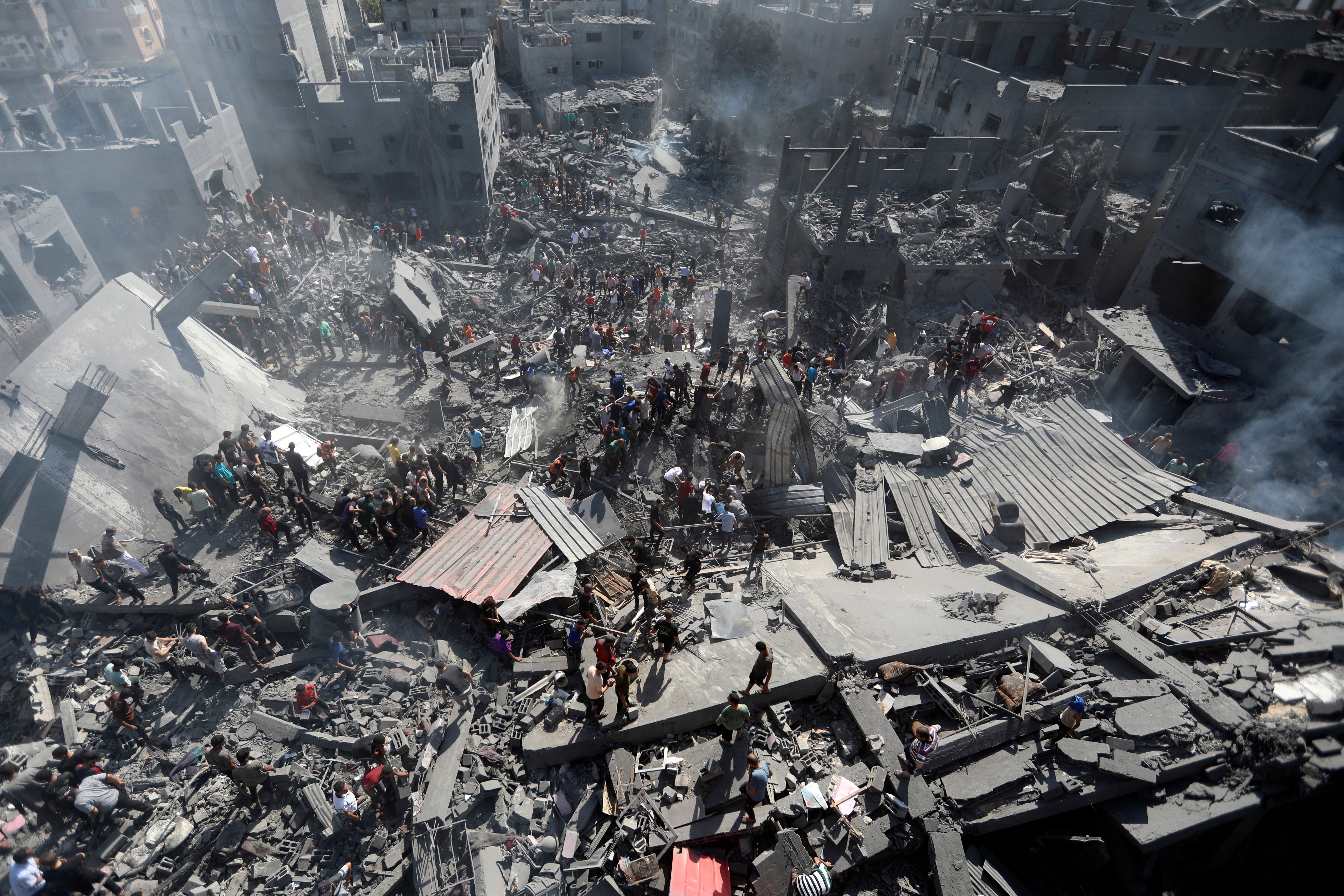Gaza map shows scale of destruction of tiny strip as Israel tanks advance
Hundreds of thousands of Gazans pushed further south as Israel deepens offensive
Israel’s ground offensive in Gaza relaunched with devastating consequences after a brief ceasefire, as hundreds of thousands are being forced to evacuate further south still, despite reports of heavy shelling.
As Israeli tanks and warplanes pummel the besieged strip, starvation has become an equally deadly threat as the UN reported difficulty in distributing food and aid due to the intensity of attacks.
The “open-air prison” - home to some 2.3 million Palestinians- has been hit with thousands of Israeli air strikes since Hamas’ attack on 7 October, destroying refugee camps, hospitals and UN-protected schools in the relentless assault on the enclave. Israel says more than 1,400 people were killed in the Hamas attacks and around 200 more were taken hostage.
A seven-day ceasefire at the end of November saw hostages and prisoners released and exchanged while Gazans were given fleeting reprieve from attacks. But by 1 December, the onslaught of strikes resumed. Within 7 hours, more than 60 people had been killed.

In recent days, Israel has ordered increasing areas of southern Gaza to evacuate- after hundreds of thousands fled to the south following Israel’s order on 13 October.
It comes as UN officials say 1.9 million people - 85 percent of Gaza’s population - are displaced by the war and describe the conditions in the southern areas as hellish.
On 4 December, Israel released a map of southern Gaza divided into blocks. Dozens of blocks in Khan Younis, where the local population has swelled to as much as 1.2 million according to local authorities, were marked for evacuation.
In a post on X, the civilians from the highlighted blocks were “invited” to move to “well-known IDP shelters” further west and south.
Displaced civilians were also fleeing to the desolate area of Al Mawasi on Gaza’s southern Mediterranean coast, which Israel has said is safe.
The former Bedouin village lacks shelter, food and other necessities, according to refugee organisations.
“There are no bathrooms. We cannot even wash if we want to pray,” displaced Palestinian Enas Mosleh told Al Jazeera television. “It is a completely remote area.”
Another Palestinian who fled to Al Mawasi, Ibrahim Mahram, said five families were sharing a tent.
“We suffered from the war of cannons and escaped it to arrive at the war of starvation,” he told the network.
“We divide one tomato between all of us.”
When did the ground offensive begin?
The Israeli military announced on 27 October it was “widening” its offensive in Gaza, after weeks of battering the strip with ceaseless air strikes. In the morning it released grainy footage of aerial and naval strikes as well as videos of tanks and infantry driving through the enclave on the 26 October.
On the night of 28 October, Israel launched its heaviest-ever bombing campaign on Gaza. “Last evening, the ground shook in Gaza,” the defence minister, Yoav Gallant, said of the bloody night. “We attacked above ground and underground. The instructions to the forces are clear. The campaign will continue until further notice.”
In a press conference on 29 October, Netanyahu declared ‘holy war’ on Hamas as he quoted the Hebrew Bible: “You must remember what Amalek has done to you”- a reference to one of Israel’s staunch enemies in the Old Testament.

It comes as at least 18,205 people have been killed in Gaza, including almost 7,729 children, the Palestinian authorities say. At least 49,645 people are said to have been injured.
Entire neighbourhoods have been destroyed, particularly in Beit Hanoun, Beit Lahia, and Ash Shuja’iyeh, Gaza City, the area between Gaza and Ash Shati’ Refugee Camp, and Abbassan Kabeera.
On average, UNRWA shelters located in the middle and southern areas are currently sheltering nine times the number of IDPs (internally displaced persons) as was planned for, the UN said.
During a visit to Rafah, China’s representative to the UN Zhang Jun – when asked by reporters if he had a message to nations which opposed a ceasefire in Gaza – said simply: “Enough is enough.”


The UN added that only 13 out of 36 hospitals in the Gaza Strip are partially functional and able to admit new patients, although services are limited, while only one of these hospitals is in the north.
The two major hospitals in southern Gaza are operating at three times above their bed capacity, while facing critical shortages of basic supplies and fuel.
Palestine’s West Bank has also been subjected to attacks as aggression from Israeli troops, air strikes and settlers have escalated since 7 October.
According to the UN, 265 Palestinians, including 69 children, have been killed in the West Bank, including East Jerusalem.
Of those killed in the West Bank, 255 have been killed by Israeli forces, eight by Israeli settlers and another two either by forces or settlers.
The UN added that this two-month toll represents “more than half of all Palestinians killed in the West Bank this year”.
Join our commenting forum
Join thought-provoking conversations, follow other Independent readers and see their replies
Comments